Lookin’ with Lambert
Kentucky Lake favorite tries to get a handle on the ledge-fishing situation
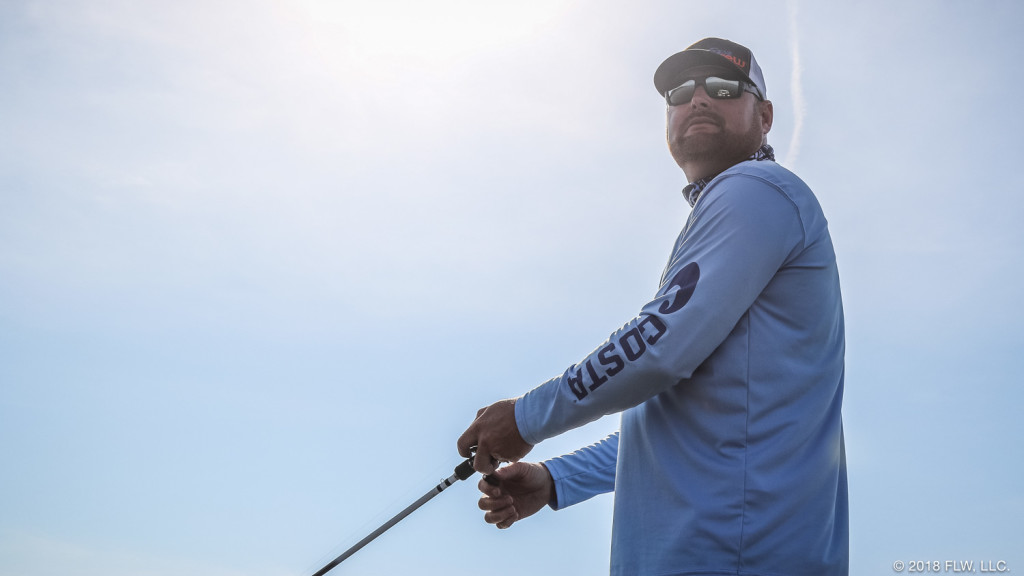
For the record, Jason Lambert didn’t catch 100 pounds the last time the FLW Tour visited Kentucky Lake. He only caught 97 pounds, 2 ounces … chump.
Just kidding. Lambert is no chump. He’s the reigning king of Kentucky Lake ledge fishing. The champ.
The Tennessean won the June 2016 Tour event on Kentucky, and defended his crown at the June 2017 Costa FLW Series event that was also held on the big pond.
This week, with the FLW Tour event presented by Costa Sunglasses about to kick off on Kentucky Lake, everyone in the tournament-fishing community is waiting to see what Lambert and the rest of the ledge experts can muster on what has become a very stingy Kentucky Lake. The fish seem to be behind schedule in their postspawn transition, and there's a lot of worry about the proliferation of Asian carp. If anyone is going to crack a big bag and unlock this puzzle right now, it’s Lambert.
Thankfully, the “Ledge Hammer” let us tag along during his final day of practice for a postspawn assessment and a morning of lookin’ at ledges.

Lambert rolls into Paris Landing State Park at about 6:30 a.m. He drops his Ranger in and goes about lining up a pile of rods on each side of the front deck.
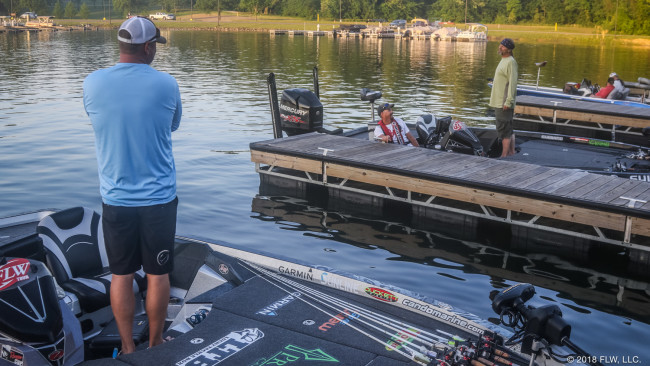
He makes small talk about outboards and carp with fellow pro Alex Davis at the dock before deploying the trolling motor and starting the day right there in the marina.
Early willow grass growth and some woody cover along the bank are likely enough spots to hit with a buzzbait, so Lambert gives them a go.
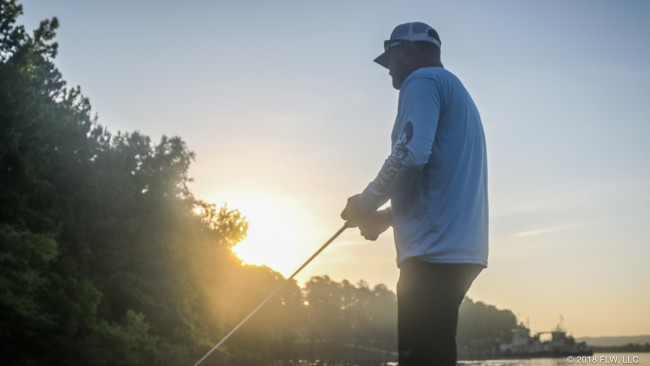
Typically, by May, Lambert would be in full-on electronics mode, scanning everything offshore and looking at nothing else. This year, the fish are behind schedule, and nothing is like normal.
“I spent an hour yesterday up shallow just throwing a buzzbait and a frog,” he says. “I figured I’d just look around here instead. Two years ago there was no need to fish shallow or have 14 rods on the deck.”
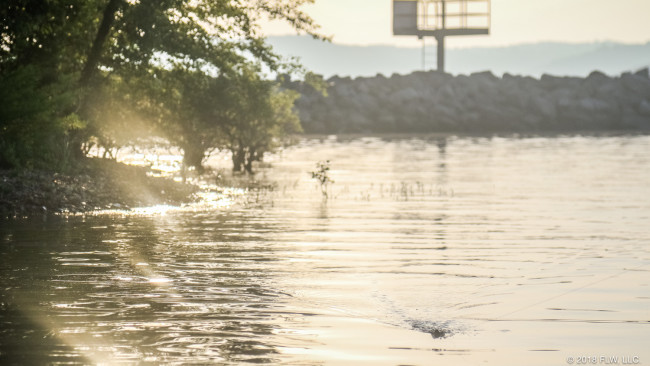
Lambert reports a decent outing on Sunday, but a much tougher day two on Monday that left him scratching his head and questioning whether or not he’s on the right track.
His plan for today is to test the shallow bite just in case before reverting back to scanning offshore. If the fish aren’t showing up on some of his favorite early ledges, he figures he’ll have to fall back to plan B and target some in-between areas that have traditionally been good to him, but are too shallow to graph.
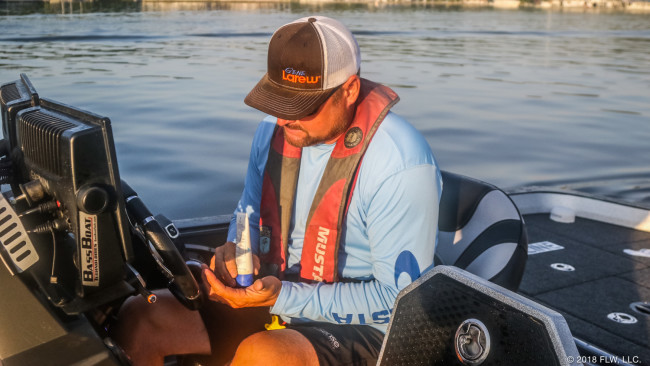
That’s enough staring at the bank. Lambert shelves the buzzbait after only about 10 minutes. He coats up with sunscreen while idling out of the marina and into the playing field that’s helped build his pro career.
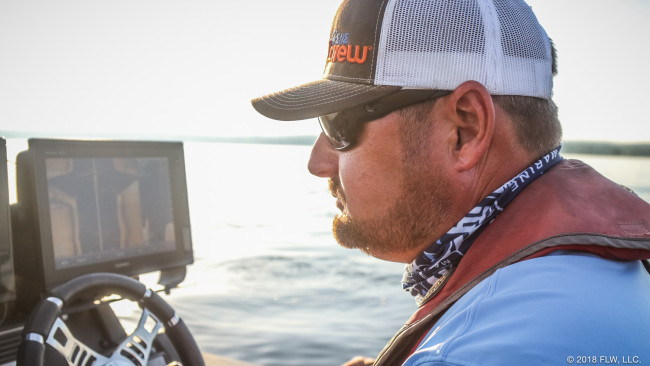
Several things are troubling Lambert during this tournament practice period, which he breaks down on a slow run to his closest waypoint.
First is the lack of bait on the ledges. He attributes part of their absence to the fact that the shad are still spawning.
“I’ve probably, in two days, seen what I’d consider big balls of bait only four or five times,” Lambert says.
Another concern is the positioning of the carp. Lambert believes the water just hasn’t gotten warm enough to push them off the same drops where he wants to target bass. Their presence makes electronic species identification tricky.
Where Lambert has found bass on ledges, they haven’t stayed put. He marks them once, or even catches a couple, then comes back later and they’re gone.

Lambert encounters that exact scenario on his first spot today. Yesterday morning, the spot held a few fish. There were fewer in the afternoon. Now, they’re gone.
“It’s just the opposite of what it should’ve been,” he says. “You should’ve been able to come back to them in the afternoon, and there should’ve been more. And they should’ve been chewing.”
The last thing bothering him is the fact that the clusters of bass he’s found in practice haven’t grown from groups to schools. Normally he'd be watching his favorite holes fill up with those early bass that are traditionally easy pickings.
“In my experience on the Tennessee River, at Pickwick and here, once they spawn, they’re gone. Fast,” he says. “When I won in 2016, I was catching fish with bloody tails.”


Lambert spends the next hour or so checking spots that are traditionally his best early places in this section of the lake. He’s scouting new arrivals and casting to some of the ledges where he marks fish to see what species is there. A Castaic Jerky J and a couple of deep-diving 6th Sense crankbaits get most of the work, with a drop-shot in reserve.
He finds a small group of what he’s confident are bass on the second spot he visits, but they won’t bite.

At about 7:30 Lambert bounces through a half-dozen drop-offs in a large creek. The spots range from underwater points to little turns and other key features. Most of his idling passes last only a few minutes before he cruises to the next waypoint.
Several tournament boats are working the same major creek when Lambert finally pulls the plug and rolls back to the main lake at about 7:45.
“This place here is a community hole because they always get here early, and they stay,” he says at the next stop.
They aren’t there yet.
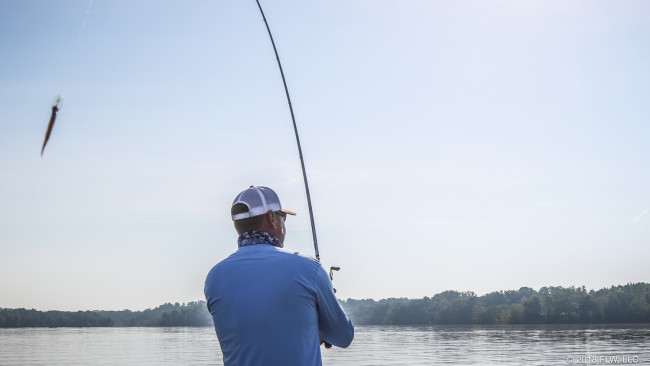
A creek mouth waypoint warrants a check, and there’s life here.
“I don’t know if that’s carp or not,” he says. “It doesn’t look like carp. They’re too close to the bottom, but it’s too many to be bass. As many marks as there are right there, if it’s bass, it won’t take long to figure it out.”

Lambert dumps the trolling motor and picks up a Jerky J to start slinging.
“As soon as I dropped the trolling motor they all came up,” he says. “That pretty much tells you what they are.”
Verification comes in the form of slime on his line, a telltale carp indicator.
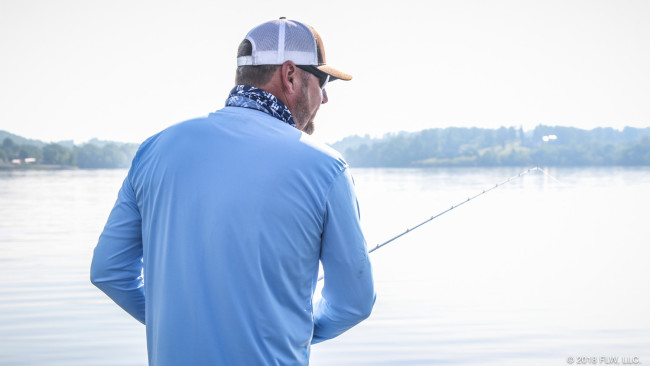
Up in a creek, Lambert idles a few spots without seeing much to interest him.
“Naturally, I’m gonna stay out here because I’ve made my career out here. But there could come a point on Thursday [day one] when I might have to move up.
“These guys that have been catching them on the bank; I really believe it’s done. The water is 85 degrees.”
A few casts to the top of a ridge produce nothing, and Lambert is off again.
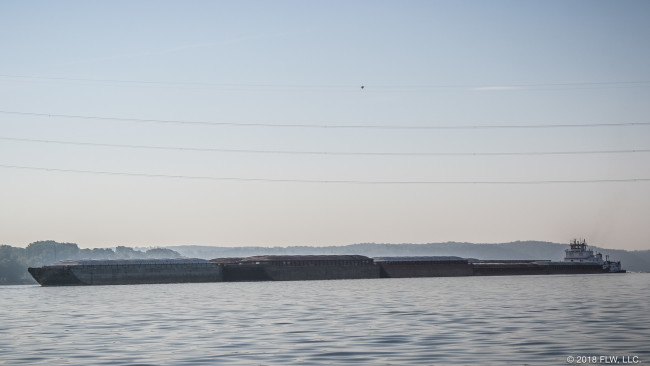
Even if Lambert believes the shallow bite is done, his competitors might have a different opinion. At least, judging by the complete lack of boats on the main lake in this traditionally strong section of the lake, you wouldn’t think there’s a ledge bite at all. The only boat in sight is a barge slowly snaking its way downstream.

The procession continues: Idle, assess whatever fish are present, cast if it looks like bass and move on. Somewhere in the middle, Lambert fields a call from FLW Field Editor Rob Newell, who’s gathering intel in preparation for hosting the FLW Live broadcast this weekend.
One nice thing about idling ledges is it’s easy to chat and look at the same time.


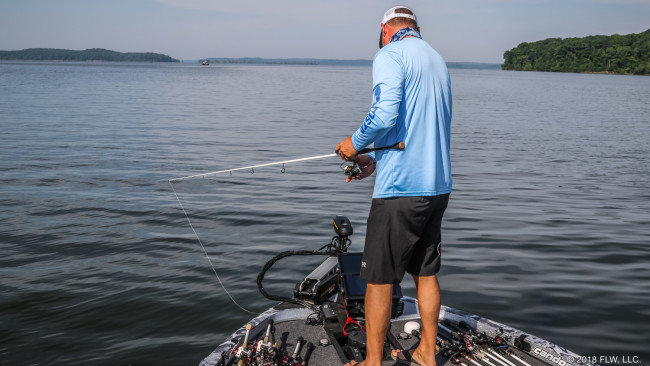
One of the tricks Lambert is employing to try to sort out bass from not is to hover overhead and dangle a drop-shot on them.
“If you pull back up on them [after idling by] and they’re gone, it’s probably carp," he says. "Usually that drop-shot will let you know if it’s bass or not.”





A quick swing into a creek to check a secondary drop produces more nothing. Then it’s back to the main lake.
“That right there looks bassy. Like, real bassy,” Lambert says as he glides over a small school of fish. The “dots” on his depth finder are situated along the bottom in the kind of nice, neat row that has made Lambert a lot of money.
He turns around to throw on them, and his Jerky J never hits the bottom.
Calmly, Lambert plays the fish, hiding it even though there’s no one around to see it – a natural practice reaction. He eases it up to the surface just close enough to take a peek.
“Ohh … we’re not throwing up there no more,” he says when he sees it’s an easy 5-pound-class fish. “Maybe they’re coming.”
He lets the fish work itself free at the boat, stows the rod and gets ready to roll away. The fish fits the trend for Lambert’s practice so far: He’s not catching many, but the fish he’s caught have all been big’uns.
“I told myself this morning I was going to do this for a while and then have to change it up and drag a rig or something on stumps. But if I can catch two or three like that, I might have to stick with it all day.”

The look-and-see-and-occasionally-cast search method continues for another hour. At one point, Lambert stops to inspect a dead fish floating nearby. He wants to know if it’s a carp or a shad. Verdict: gizzard shad, aka, bass food.
The most action he gets is a nibble or two on a drop-shot, which he blames on white bass, and a spot where he declares there are exactly three bass.

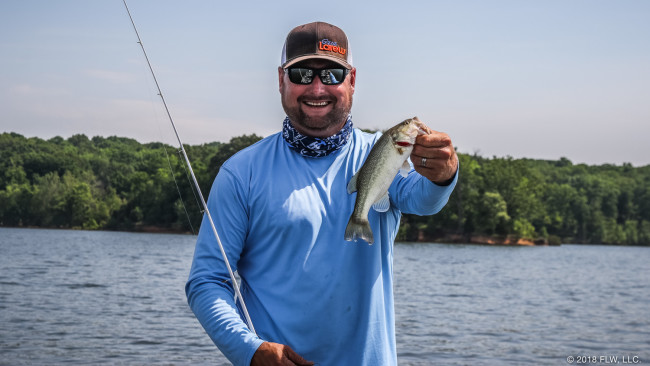
Lambert strikes out on a few waypoints where he’s caught them “a million times.” Unsure of what he sees on the next spot, he decides to drop on them.
“These here didn’t really look like bass, but you’ve got to check ’em,” he says. A second later, a non-keeper gets lifted into the boat. “One of ’em was a bass.”


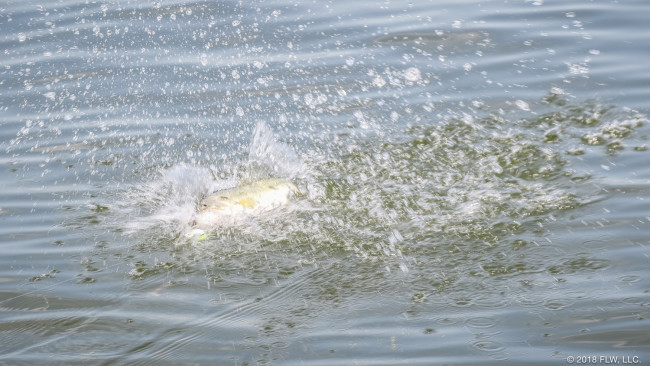
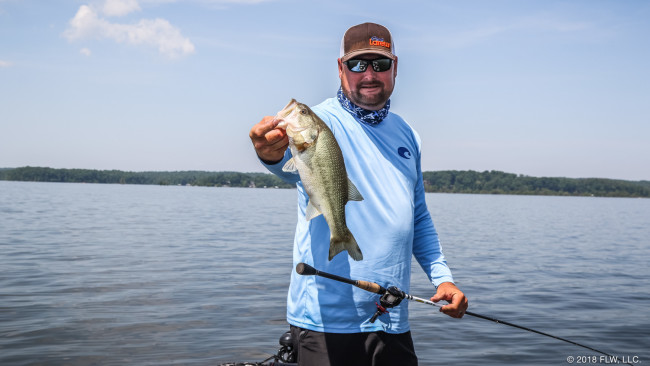
Fifteen minutes later, Lambert finds a similar scenario. The fish on this spot look “bassy,” but they won’t take a swimbait, and even though several fish peck at his drop-shot, he can’t get a good bite.
It prompts him to back off and launch a crankbait at them.
Bingo: Keeper No. 2 is a 3-pounder.
“I still have my fingers crossed they’re coming,” he says, but five more minutes of casting and longlining can’t generate another taker.
“There are so many down there I didn’t think it would hurt to catch another one, but I can’t catch another one.”

The rest of the morning follows the same script – look, test and move on. Lambert’s not checking anything new. He knows where they should be.
The highlight of late morning is a brief stop under the bridge at Paris Landing, where the shadow of the roadway overhead offers some relief from the bright sun.
Practice days have all been scorchers, causing the water temperature to jump nearly 10 degrees in some areas. It’s a perfect scenario to drive fish to the ledges and make them congregate in tight schools. However, the tournament forecast calls for intermittent showers and thunderstorms for four straight days – the opposite of what Lambert would prefer.
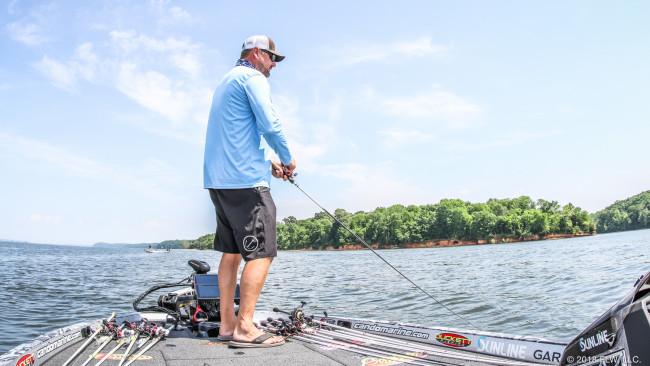


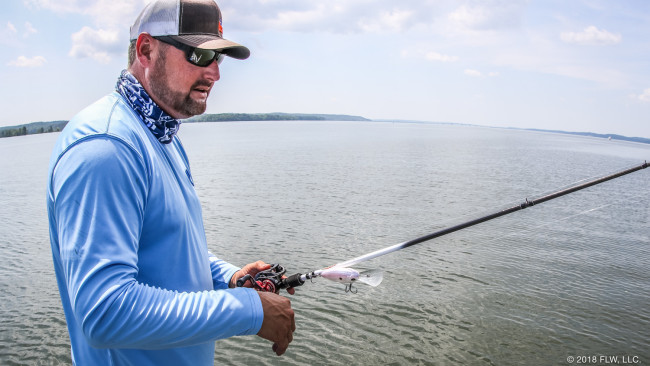
A few more stops round out Lambert’s morning before he idles back to the ramp to drop me off.
It’s not a normal May on Kentucky Lake, that’s for sure, and Lambert’s confidence is suffering from the unusual circumstances.
Still, he seems convinced that the fish are coming to him, and that he won’t have to resort to anything but living on the ledges, which is where he wants to be.
Today’s practice outing convinces him that, even though bites are tough to come by, and he won’t be sorting through 70 schools and 100 bass per day, Kentucky Lake’s river ledges still might hold the kind of fish that he’ll need to catch to remain atop the podium in the Tennessee Valley.